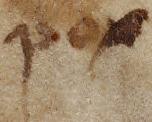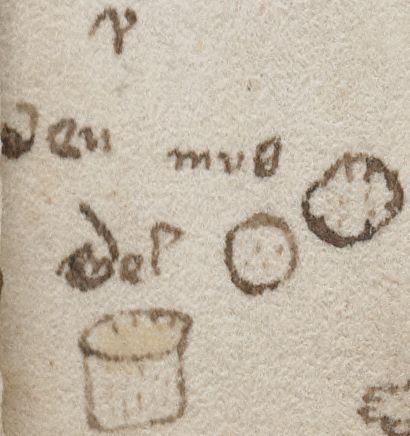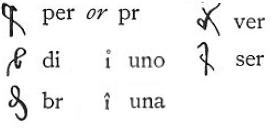Edith Sherwood recently posted up a webpage comparing one of Leonardo da Vinci’s abbreviations with the third character on the Voynich Manuscript’s back page. She says that this is an ‘x’ – a letter which doesn’t appear in Italian, but which Leonardo often uses to denote “ver“. Might she be right?

Just to be sure, let’s zoom right in on that first word: is this ‘pox‘, ‘pof‘, or ‘por‘ (etc)?

Does that first letter seems oddly familiar? Let’s look at the letters in the bottom-left margin of f66r:-

So, the stakes are high insofar as these pieces of added writing (on f116v and f66r) both appear to be by the same hand – and so understanding one better might well also help us decrypt the other.
Anyway… for her ‘x’ claim, Edith refers us to the “Clavis sigillorum” (key to the ‘seals’ i.e. to the special symbols) on pages 1-4 of Jean Paul Richter’s (1883) “The Literary Works of Leonardo Da Vinci” (later reprinted as “The Diaries of Leonardo da Vinci”), which we can now see online here, courtesy of Cornerstone Book Publishers (who publish a zesty mix of Masonic, Esoteric & Pulp Fiction books, just so you know). In common with many other Quattrocento Florentines, Leonardo often placed a (nasalizing) bar above a, e, i, o, and u to indicate an, en, in, on, and un (or sometimes am, em, etc). But the special abbreviating symbols he used were:-

So, as you can see, Leonardo did indeed use an ‘x’-like abbreviation for ver: but is this what we see on f116v? To my eye, there’s something that doesn’t quite ring true: partly because the distinctive shape used by Leonardo is not really present – but mainly because the ‘x’-like character that is there has so clearly been emended by someone using a different colour ink.
It therefore seems very likely to me that a later owner guessed that this should read ‘pox‘ (for whatever reason) and emended it accordingly: but was this (as Edith Sherwood claims) what was originally written here? I think very probably not. So… what does it say, then?
Back in 2006, I hazarded a guess (Curse, p.27) that this line was written in Occitan and originally read “por labor a mon aut…” followed by EVA ‘och‘ (Voynichese): now, though I still suspect Occitan, my current reading (somewhat to my surprise) is that it starts with “por le bon simon s…”
Lest you think this is some kind of slightly delayed April Fool’s joke (and that I’m trying to sneak in a reference to Duran Duran singer/lyricist Simon Le Bon), please be assured that it’s honestly not – “le bon simon” is simply what it seems to say in this (admittedly much-disputed) margin. Unless you know better? Look at it for yourself and feel free to post your own reading!
And finally… here’s a link to a nice little web application that transforms a message you type in into Leonardo’s handwriting. Now that you are an expert on Leonardo’s abbreviations, you should quickly realise that this fails to handle both “per“, “ver“, “di“, “br“, “ser“, “uno“, and “una” and “an“, “en” (etc) properly. Incidentally, Leonardo also replaced “j” for “i” if it was next to an “n” (so that the resulting letter-pair wouldn’t get confused with an “m“), which this (otherwise very cool) app also doesn’t handle correctly… but perhaps I’ve covered enough arcane palaeographic ground for one day, and should stop there! 🙂
